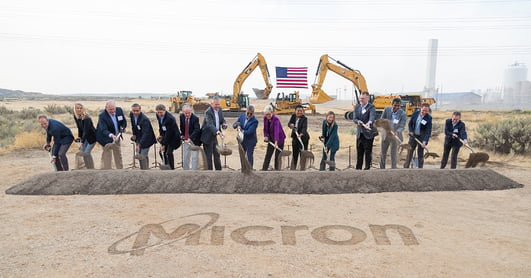Micron Boise plant project fuels need to grow at Local 69
Insulators International Staff — Fri, Feb 9, 2024 @ 16:02 PM
Local 69, Salt Lake City, is preparing for the biggest project in Local history.
With its membership slightly over 100 members, Local leaders are in full recruitment mode as they estimate a need for 200 to 300 members by 2025.
At the heart of the projected membership growth is a $15 billion megaproject to construct a new semiconductor manufacturing plant in Idaho. A megaproject is defined as a privately funded construction project that costs a minimum of $1 billion.
In 2022, Boise, Idaho-based Micron Technology, Inc., a world leader in innovative memory solutions, announced it would spend $15 billion to build a new semiconductor manufacturing plant, called a fab, in Boise, to be co-located with the company's R&D center.
Cleanroom space in the new fab is expected to come online in phases starting in 2025, with dynamic random access memory (DRAM) production ramping up over the second half of the decade.
Ultimately, the cleanroom space will reach 600,000 square feet -- the size of approximately 10 football fields. Once completed, the fab will be the single largest cleanroom ever built in the U.S.
According to its website, Micron will directly infuse $15.3 billion into the Idaho economy and directly spend $13 billion with Idaho businesses throughout the life of the project. It will create over 17,000 new Idaho jobs, including 2,000 Micron direct jobs.
For Local 69 Business Manager Steven Overby and Organizer Sabino "Edz" Arciga, the push has begun to organize non-union members to man this project.
As of mid-November, Micron was in ongoing talks to finalize a Project Labor Agreement, which he thinks will be key to keeping the megaproject on schedule and on budget.
The anticipated work has been a good selling point to organize the non-union sector, but he cautioned that the skills gap between his members and non-union insulators is significant. As such, many of those being organized will join the Local as apprentices.
This will benefit Local 69 in the long run, but it leaves a critical need for journeyman-level mechanics to construct the Micron project.
"Plenty of our apprentices have two years or less experience," Overby said. "We need guys who have wrapped pipe."
Micron held a groundbreaking ceremony on Sept. 12. Insulators will not be needed onsite until the fall of 2024. At its peak, the megaproject will require at least 50 Insulators -- roughly half of the Local's current membership, which creates a challenge for Overyby and Arciga as their normal day-to-day routines have not disappeared.
"It's a challenge. We have more than one contractor in the area, and we are urging members to stay loyal to their current contractor," said Overby.
Another factor affecting the Local is the location of its JATC in Salt Lake City. It is roughly a five-hour drive between Boise and Salt Lake City, which makes training workers for the clean room environment difficult.
However, Micron and the HFIAW are both pitching in funds to build a satellite Training Center in Boise, where the JATC can train apprentices and provide journeymen with clean room training.
Overby said working in a clean room environment can be challenging because a lot of the work will be prefabbed and those working in the clean room will need to be prepared to properly install the mechanical insulation in that environment.
Journeymen are also needed to perform maintenance work on the current Micron Boise facilities. Currently, there are 26 insulators working onsite full-time, but an additional 14 are needed.
"This is permanent work and Micron wants to hire local Insulators to do this work," Overby said.
Besides the Micron project, the future work outlook in the Local 69 jurisdiction is very good.
About 16 miles southwest of Boise is an $800 million Meta datacenter project, which broke ground in September and is scheduled to be completed in 2025.
Construction is set to begin in the next year or two on a nuclear fuel fabrication plant at the Idaho National Laboratory near Idaho Falls.
Furthermore, the area building trades are making headway with the current Salt Lake City administration to gain more work. The educational push is paying off, as more work is going to the building trades union.
Overby is hopeful that work on Phase 3 of the Salt Lake City Airport may go union, and if it does, he believes his Local will have the numbers to man that job.
The upcoming work outlook is a lot for the Local, but Overby said the membership needs to take an active role to help expand the union. He added that Western States International Vice President Ricky J. Johnson is doing everything he can to help.
As the demand for union Insulators grow in the jurisdiction, Local 69 itself is posed for change.